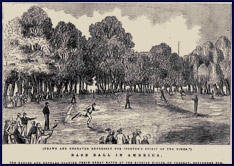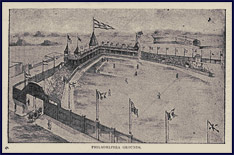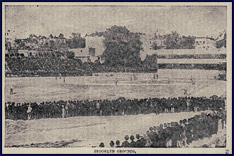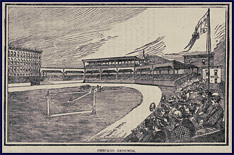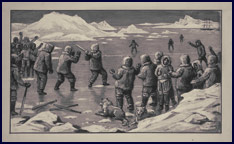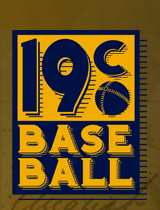The Batter's Area and Position (Pre-1856 to 1873)
By Eric Miklich
Introduction
 he batter's area experienced numerous physical changes as well as numerous rules changes in the 19th century. As the rules makers felt the batter was gaining the advantage over the pitcher, rules were instituted to combat the discrepancy. Home base change composition two times, shape three times and position on the field five times during the 19th century.
he batter's area experienced numerous physical changes as well as numerous rules changes in the 19th century. As the rules makers felt the batter was gaining the advantage over the pitcher, rules were instituted to combat the discrepancy. Home base change composition two times, shape three times and position on the field five times during the 19th century.
Pre-1856
Prior to 1856, batters were free to move however and wherever they wanted when hitting the ball as long as they stood back of the six foot line crossing home base (three on either side of the base). There was no written rule regarding a "striker's line" drawn on the playing field, it was accepted as there was also no written rule that restricted the pitcher from delivering the ball 45' from home base, which has also always been assumed. The pitchers tossed the ball to the batters and did not pitch to induce the batters to make out. The umpire did not "warn" the batter for not swinging at good balls and the batters could be as selective as they wanted. The theory was that the defense was to decide the game. As the batters became more aggressive, they began moving toward the pitcher, sometimes many feet, when striking at a pitched ball.
1857
The 1857 base ball convention was very important in beginning the ground work for more specific rules written in the playing code. Regarding the batter's area, the rules stated that Home Base was to be circular and made of flat iron and painted or enameled white, a practice that was an unwritten rule probably beginning around 1845. It was to be centered on the "corner" of the infield that was designated as home. Although not specifically stated; home base was most likely between nine and 12 inches in diameter.
The batter was required to stand on a line drawn through the center of Home Base which was to be three feet on either side of the base. There is no language defining if the batter had to keep one foot on the line throughout his time at bat or was able to remove his foot, during the act of swinging.
The bats were mandated to be round, of any length and no more than 2½ inches in diameter in the thickest part. A.T. Pearsall of the Excelsior Club of Brooklyn was known to use a bat 50 inches long and only two inches in diameter during the 1857 season.
NOTE: It was not until the 1868 season that the bat was limited to 42 inches in length.
1858 - 1863
Strikes were allowed to be called on the batters for the 1858 season and balls were not called on the pitchers until the 1863 season. Before either was assessed to their respective parties a warning was to be given by the umpire. There was no mandate as to how many "good" pitches a batter refused to swing at or how many "unfair" pitches were delivered before the umpire announced a warning and subsequently balls and strikes.
Beginning in 1859, Jim Creighton changed the role of the pitcher. He viewed the pitcher and his responsibility of delivering the ball as an asset and an addition to the team's defense. When his style of fast and slow accurate pitching began to be used by other pitchers, strikers lost their monumental advantage.
Batting Rules
From 1857 through 1866 the rules regarding batting read as follows: (Taken from Porter's Spirit of the Times and Beadle's Dime Base Ball Player).
"The striker must stand on a line drawn through the center of the home base, not exceeding in length three feet from either side thereof, and parallel with the line occupied by the pitcher."
NOTE: The Batter's Line was not required to be marked on the field with chalk until the 1870 season.




